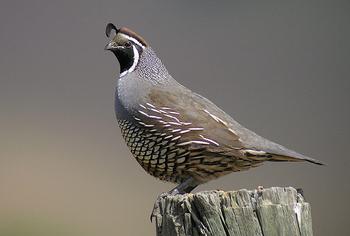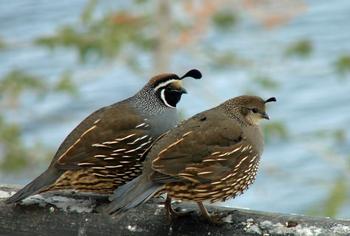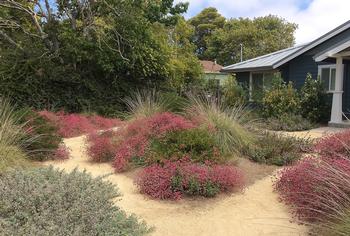Welcome California’s bird into your garden
-
Marie Narlock
-
No offense to my friends and family, but some of the best visitors I’ve had in my garden recently have had wings, not arms. This time of year, birds seem to arrive in droves -- some to nip off seedpods from spent flowers, others to splash, drink, and dive in and out of my fountain. But my favorite avian guests, a covey of California quail, arrived on foot. They scampered lickety-split up my garden path, pecking, scratching, and darting in and under shrubs as if playing a game of hide-and-seek.
 California quail live on the west coast from Canada to Baja, primarily in woodland edges, coastal scrub, parks, and farms. Flickr
California quail live on the west coast from Canada to Baja, primarily in woodland edges, coastal scrub, parks, and farms. FlickrThe patriarch, assuming his role as sentinel, positioned himself atop a shrub and chirped pit-pit-pit to alert the covey of any danger. The rest of the gang relied on their iconic Chi-CAAA-go call to announce occasional separation from the group. I enjoyed this quail choir for a solid fifteen minutes before they darted off to forage elsewhere.
It’s hard not to smile when you see quail. These aptly-labeled charismatic birds always look like they’ve just finished Thanksgiving dinner, their bellies pleasantly plump.
The male sports the iconic plume that resembles a quotation mark sprouting from his head but is actually six interlocking feathers. He boasts a flashy combination of feathers with a black face outlined in white. Such a handsome fella! The male California quail has the iconic plume and outlined face, while the female's less flashy appearance provides camouflage when nesting. Flickr
The male California quail has the iconic plume and outlined face, while the female's less flashy appearance provides camouflage when nesting. FlickrHis female counterpart, on the other hand, is more subdued. And it’s a good thing she is because her muted brown feathers and lack of facial markings provide camouflage when nesting. Quail nest on the ground, typically under shrubs or brush piles and sometimes in broken-off branches or previously-used birds’ nests. This makes them vulnerable to numerous predators, including bobcats, squirrels, owls, skunks, snakes, and domestic cats.
Can coyotes help quail?
The California quail, Callipepla californica, lives in healthy populations on the west coast from Canada to Baja, primarily in woodland edges, coastal scrub, parks, and farms. It’s our state bird as well as the official bird of San Francisco. Ironically, however, the quail population in San Francisco has dropped precipitously in the past few decades, and reintroduction efforts have failed. Today, the California quail is considered extinct in San Francisco.
Land managers are now considering another attempt at reintroducing these birds into San Francisco. One surprising factor that may lead to success is the growing population of coyotes. Although it’s counter-intuitive, researchers have found that parks with coyotes have a 73 percent higher likelihood of quail presence than in similar parks without coyotes. The thinking is that coyotes may keep populations of smaller quail predators like rats and raccoons in check.
How to invite quail into your garden
Every living creature needs food, water, and shelter, and quail are no exception. In addition to providing a shallow dish of water at ground level, here are the three things you can do to roll out the welcome wagon for quail. This quail-friendly garden features buckwheat, Ceanothus, and sage for cover and taller trees for roosting. Flickr
This quail-friendly garden features buckwheat, Ceanothus, and sage for cover and taller trees for roosting. FlickrFirst, provide thick shrubs for cover. This is where quail hide, rest, and nest. Stick with California natives. Some plants that work well for this include quail bush (Atriplex lentiformis), holly leaf cherry (Prunus ilicifolia), coffeeberry (Frangula), toyon (Heteromeles arbutifolia), California lilac (Ceanothus), wormwood (Artemisia), currants (Ribes), sage (salvia), sugar bush (Rhus ovata), lemonade berry (Rhus integrifolia), redberry (Rhamnus crocea), and Pacific blackberry (Rubus ursinus).
Next, provide open areas with lower-growing plants and annuals, such as native wildflowers. This is where quail forage for food. Good contenders include lupine (Lupinus bicolor and L. nanus), clover (Trifolium), deerweed (Lotus scoparius), buckwheat (Eriogonum), and bush sunflower (Encelia californica). Quail especially enjoys seeds in the pea family (lotus, lupine, and clover).
Finally, provide trees or taller shrubs for roosting. This is where quail sleep. Manzanita and Ceanothus are good choices. Oaks are excellent because they provide both food (acorns) and roosting sites.
Avoid spreading birdseed to lure quail because you will likely lure rats as well. Also, please keep kitties indoors. Cats kill an estimated 2.4 billion birds every year.



